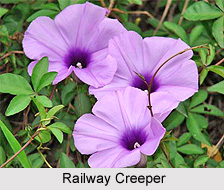 Railway Creeper is a medicinal plant commonly found in India. The plant is an extensive perennial climber. Its native range is uncertain, though it is believed to originate from a rather wide area. The botanical name of Railway Creeper is Ipomoea cairica morning glory. Railway Creeper is the English name of the plant and it is called as Bekkina Hejje in Kannada. It has many other names including mile-a-minute vine, Messina creeper, Cairo morning glory and coast morning glory.
Railway Creeper is a medicinal plant commonly found in India. The plant is an extensive perennial climber. Its native range is uncertain, though it is believed to originate from a rather wide area. The botanical name of Railway Creeper is Ipomoea cairica morning glory. Railway Creeper is the English name of the plant and it is called as Bekkina Hejje in Kannada. It has many other names including mile-a-minute vine, Messina creeper, Cairo morning glory and coast morning glory.
Characteristic Features of Railway Creeper
The plant has tubercle stem and tuberous rootstock and its leaves are ovate to orbicular in outline. The leaves are 3-10 cm long and wide and the 5-7 lobbed leaves are deeply palmate. The lobes are lanceolate to ovate or elliptic, and they are acute or obtuse and mucronate at the apex, having a length of 3-5 cm. The flowers of Railway Creeper are usually borne on pedicels that are 1.2-3 cm long and the 4-6.5 cm long sepals are ovate, obtuse to acute and mucronate. The plant`s corolla is of purple, blue-purple or white colour, having a purple centre and its shape is like a funnel. The 4.6-6 cm long corolla is borne 1 or 3 together in axillary cymes. The plant`s fruits are capsular, sub-globose, having a length of 1-1.2 cm and they are also glabrous. The sub-globose to ovoid seeds of the plant are usually 4 and they are blackish to tan. They have a length of 0.4-0.6 cm and the densely short-tomentose seeds sometimes have long silky trichomes along the edges. The plant usually produces flowers and fruits throughout the year.
Habitat of Railway Creeper
The plant is most commonly grown in gardens, on trellises and railway platforms as screens, in India and it has been naturalized in many parts of the country as well. The plant is a common one in western peninsular India, and it grows on open, disturbed sites, in thickets and hedges, along streams, and also in fallow agricultural fields.
Medicinal Uses of Railway Creeper
Railway Creeper has some useful medicinal properties and usages. The seeds of the plant are considered purgative and are commonly used as a substitute for those of Ipomoeanil that are sold commercially for this purpose. Apart from the seeds, the crushed leaves of the plant are also reported to be applied externally for getting relief from body rashes.











